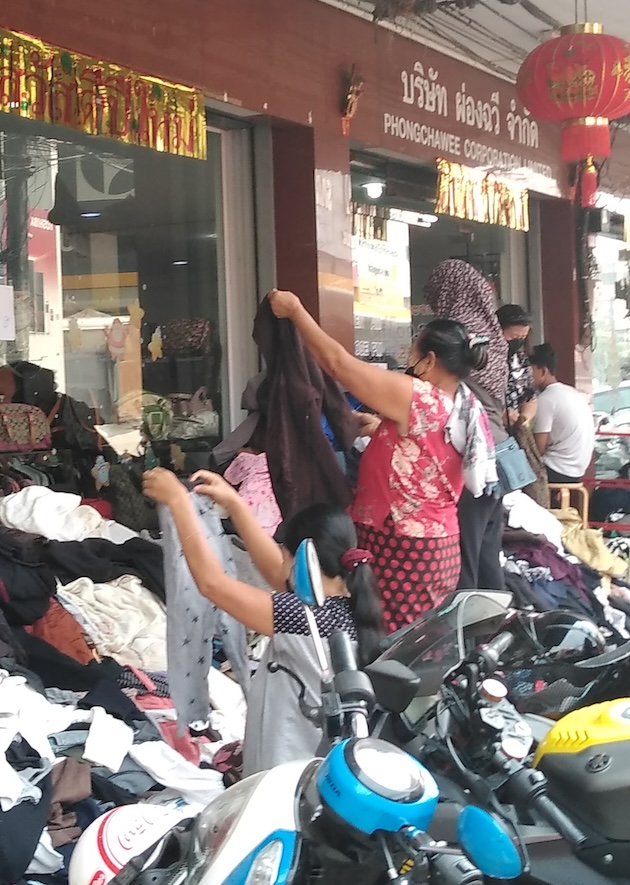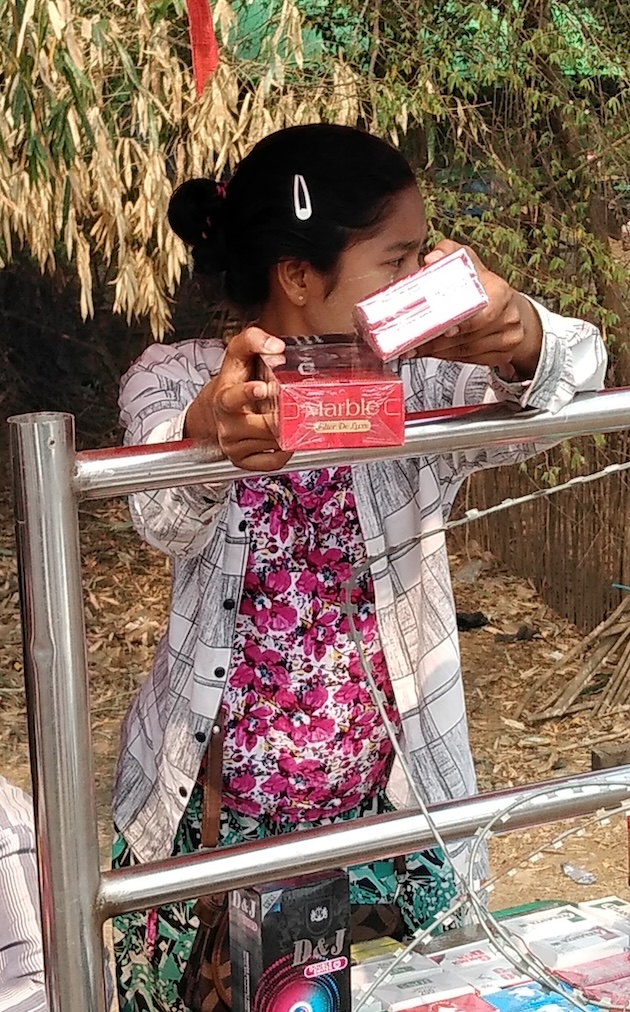By William Webb
MAE SOT, Thailand (IPS) – The Maung family is rebuilding their lives in a foreign land. A freshly painted signboard with a play on the word Revolution declares their small restaurant is open for business, and breakfast features traditional Myanmar mohinga—rice noodles and fish soup.
Three years ago, the family of four was prospering in the central Myanmar city of Mandalay but suddenly everything changed. The military seized back power from the newly elected government, and thousands of people took to the streets in protest, including the Maungs. A brutal crackdown ensued across Myanmar, the father was arrested and their two restaurants seized.
Since the 2021 coup, the UN estimates some 2.4 million more people have been displaced by conflict across Myanmar, while 78,000 civilian properties, including homes, hospitals, schools, and places of worship, have been burnt or destroyed by the military.
The Maung family was wise to leave Myanmar when they could, and fortunate to survive the hazardous journey eastwards towards the border with Thailand. After spending a year in a border camp for IDPs run by the military wing of the Karen National Union (KNU) in eastern Kayin State, the family managed to cross into the Thai frontier town of Mae Sot to start afresh, even if they exist in a grey zone of legality alongside tens of thousands of others.
More waves of refugees are following in their footsteps.
“We have 750,000 IDPs in our territory,” said a senior official of the KNU, which has been waging the world’s longest civil war against successive Myanmar regimes since 1949. “A year ago, there were 500,000 to 600,000. Numbers are rising because the military is deliberately targeting civilians,” he told IPS in Mae Sot, asking not to be named.
Against this background and wanting to preempt an influx, Thailand’s new coalition government announced its intention last month to open up a ‘humanitarian corridor’ into Myanmar to funnel aid to IDPs and keep them well away from the border.

Thailand’s military—the real arbiter of power in these border regions and holding sway over two parties in the coalition—is haunted by the spectre of past and present examples of chaos through conflict. In the 1980s, Thailand reluctantly hosted several hundred thousand Cambodian refugees, including remnants of the genocidal Khmer Rouge regime, on its eastern borders. Today it looks west and sees Bangladesh struggling to contain in camps some one million Rohingya refugees forced out of Myanmar in what the UN special rapporteur on human rights called a genocidal campaign by the Myanmar military.
But beyond the ‘humanitarian’ aspect, what has caused anger within the various groups fighting the Myanmar military as well as rights activists, is Thailand’s own admission that its humanitarian corridor proposal is aimed at drawing the regime’s State Administration Council (SAC) into a dialogue that would lead to a negotiated settlement with Myanmar’s diverse resistance forces.
Neither the KNU nor the parallel National Unity Government set up by ousted Myanmar lawmakers after the coup were consulted by Thailand, which received a green light from the Association of Southeast Asian Nations (ASEAN).
Under Thailand’s initiative, aid would be delivered initially to 20,000 IDPs by the Thai Red Cross and the Myanmar Red Cross (whose senior administrators are former military officers) and monitored by ASEAN’s Coordinating Centre for Humanitarian Assistance on Disaster Management, where the Myanmar junta also has a presence.
“Aid is used everywhere in the world as a political entry point,” the KNU official commented. “This is not a pure humanitarian issue. They want to bring the SAC out of isolation. This is very problematic for us.”
A senior NUG official, also based in Thailand, was similarly concerned by the political intentions behind the proposal. “It’s a desperate measure by ASEAN seeking a semblance of negotiated peace and dialogue,” he told IPS.
The official doubted it would get off the ground in its present form without the support of the Karen forces that control large areas of Kayin State, nor without the full backing of the US.
The US values its long-held strategic ties with Thailand and its military, and Thai Foreign Minister Parnpree Bahiddha-Nukara returned from Washington last month, declaring that he had secured complete US support for the initiative, although the US public statement appeared more cautious.
Human rights activists and humanitarian workers on the Thai-Myanmar border remain highly sceptical of the initiative, denouncing it as a “weaponization of aid”.
Thailand, they note, has never officially recognized the refugee status of nearly 100,000 people living in nine UNHCR camps along the Thai-Myanmar border since the 1990s.
“This is not about providing humanitarian aid to the people of Myanmar. It is about giving a new lifeline to the junta to re-engage with ASEAN and everybody else,” commented Paul Greening, a former UN senior staff officer and now independent consultant in Mae Sot.
“Neighbours and other international actors, including the US and China, do not want the junta to fall. They do not want the junta to win but they do not want it to fall either. This is why they all want a ‘negotiated settlement’,” he said.
Igor Blazevic, a senior adviser at the Prague Civil Society Centre who previously worked in Myanmar, said a “carrot” was being held out to the Myanmar regime at a time when it was “seriously weakened and shaken” after losing large areas of territory to resistance forces both in Rakhine State in the west and in Shan State close to China.
“A political aim behind the ‘humanitarian initiative’ is the intention to treat genocidal power-usurpers in uniform as the inevitable and unavoidable key factor in Myanmar’s ‘stability’ and with combination of soft pressure and humanitarian incentives, try to force everybody else to surrender, in a soft way, to ongoing military dominance in politics and the economy,” Blazevic wrote in a commentary.
With the UN warning that nearly two million people in Myanmar are expected to fall into the “highest category of needs severity (catastrophic)” this year, the resistance is aware that they will come under intense international pressure not to reject the Thai initiative.
Recent developments indicate Thailand may rethink its proposal, however. It has opened channels with the KNU and the NUG to discuss their involvement in facilitating aid deliveries through Myanmar civil society organisations independent of the regime. Word has it that the Myanmar Red Cross is not that keen to be directly involved, knowing it is too close to the regime to be able to safely deliver aid to those who have suffered atrocities at its hands.
For the Maung family and their small eatery in Mae Sot, a dream would be to return to Mandalay and Myanmar in peace. But they have little hope of such an outcome, nor do they really want to remain in Thailand, along with over two million other Myanmar workers, classified as migrants, not refugees.
For the moment, life revolves around navigating Thailand’s complex and often corrupt system to secure papers that would give them a degree of legitimacy and enable them to move beyond Mae Sot and surrounding Tak Province. A possible lifeline is an ethnic Chinese branch of their family with members in Taiwan.
“Taiwan could be our future,” says the elder of two daughters, who still dreams of going to university. “I can learn Chinese,” she says, in excellent English.
INPS Japan/ IPS UN Bureau Report


